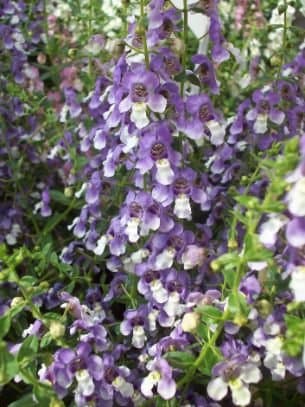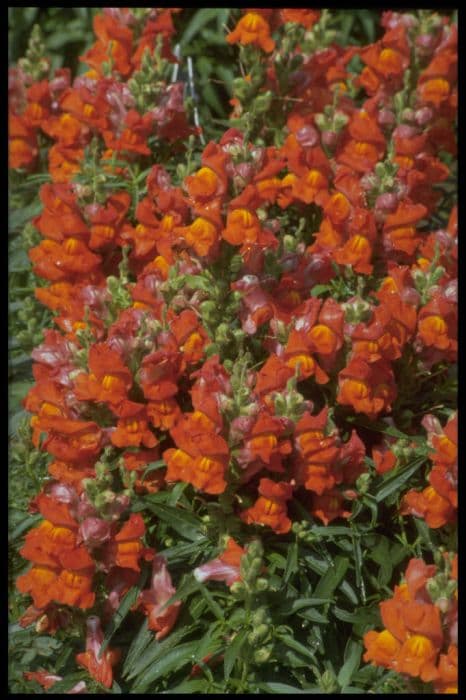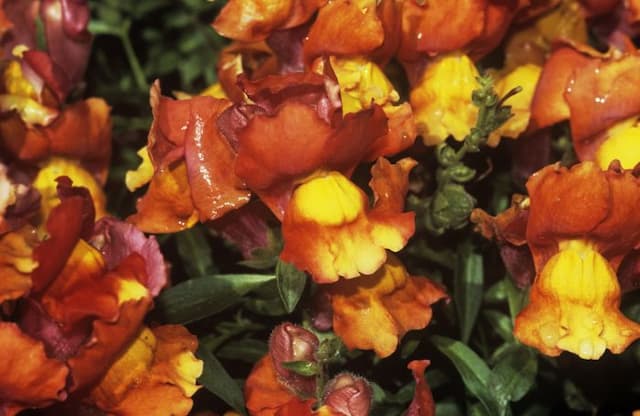Smooth Beardtongue Penstemon glaber 'Roundway Snowflake'

ABOUT
Penstemon glaber 'Roundway Snowflake', commonly known as Smooth Penstemon, boasts a striking appearance that makes it a favorite for garden enthusiasts. This variety is distinguished by its beautiful, tubular flowers that exude a pristine, snowy white color. The blossoms are tightly clustered together on the stem, resembling little bouquets that contrast sharply against the plant's backdrop of foliage. The leaves of the Smooth Penstemon 'Roundway Snowflake' are typically a rich, deep green, providing a lush background for the stunning white flowers. These leaves are often lance-shaped, smooth, and sometimes have a glossy appearance, further enhancing the overall attractiveness of the plant. The floral display is particularly eye-catching as it emerges on tall, upright stems, giving the plant a graceful, yet robust character. These stems carry the flowers aloft, allowing them to sway gently with the breeze, adding movement and dynamism to a garden setting. As a perennial, the Smooth Penstemon 'Roundway Snowflake' returns year after year, bringing with it the delicate charm of its flowers. When in bloom, the plant is a magnet for pollinators such as hummingbirds and bees, which are attracted to the tubular flowers seeking nectar. Overall, Penstemon glaber 'Roundway Snowflake' is notable for its elegant, snowy flowers that create a stunning contrast with its dark green leaves, providing a beautiful addition to any garden without the need for a detailed account of its dimensions.
About this plant
 Names
NamesFamily
Plantaginaceae
Synonyms
Smooth Beardtongue, Roundway Snowflake Penstemon
Common names
Penstemon glaber
 Toxicity
ToxicityTo humans
Penstemon, commonly known as beardtongue, is not listed as a toxic plant to humans. In general, ingestion of non-food plants should be avoided due to the potential for allergic reactions or other mild gastrointestinal upset, but beardtongue does not typically contain poisons known to cause serious harm to humans.
To pets
Beardtongue is not commonly listed as a toxic plant to pets either. Like with humans, the consumption of non-food plants by pets should generally be discouraged, and there is always a risk of mild gastrointestinal upset. However, no specific toxic principles are known to cause serious poisoning in pets like cats and dogs from consuming beardtongue.
 Characteristics
CharacteristicsLife cycle
Perennials
Foliage type
Deciduous
Color of leaves
Green
Flower color
White
Height
2 feet (60 cm)
Spread
2 feet (60 cm)
Plant type
Herb
Hardiness zones
3
Native area
North America
Benefits
 General Benefits
General Benefits- Attracts Pollinators: Penstemon glaber 'Roundway Snowflake' is particularly attractive to hummingbirds and bees, enhancing pollination in the garden.
- Drought Tolerance: Once established, this plant has good drought tolerance, making it suitable for xeriscaping or low-water gardens.
- Ornamental Value: With its attractive white tubular flowers and semi-evergreen foliage, it adds aesthetic appeal to gardens and landscapes.
- Cold Hardy: It can tolerate cold temperatures, making it a viable option for planting in cooler climates.
- Low Maintenance: Requires minimal upkeep once established, making it an ideal plant for gardeners seeking low-maintenance landscaping options.
- Long Blooming: It has a long flowering period, which ensures that gardens have color and interest for an extended time.
- Adaptability: Able to grow in a variety of soil types, although it prefers well-draining soils.
- Erosion Control: Its root system can help stabilize soil and prevent erosion on slopes or in areas with loose soil.
- Wildlife Habitat: Provides shelter and nesting opportunities for various small wildlife and insects.
- Versatility: Can be used in a variety of garden designs, including borders, rock gardens, and wildflower meadows.
- Non-Invasive: Unlike some garden plants, Penstemon glaber 'Roundway Snowflake' is not known to be invasive, reducing management efforts to keep it contained.
 Medical Properties
Medical PropertiesThis plant is not used for medical purposes.
 Air-purifying Qualities
Air-purifying QualitiesThis plant is not specifically known for air purifying qualities.
 Other Uses
Other Uses- As a natural fabric dye, the leaves and flowers of Beardtongue can be used to impart a subtle color to textiles.
- Pressed flower art, where the blossoms of Beardtongue make attractive components in framed floral compositions due to their distinct shape.
- In photography, Beardtongue's distinctive flowers can serve as an ideal subject for macro photography workshops and projects.
- Garden boundary definition, with their upright form, Beardtongue species can be used to delineate spaces within a landscape design.
- Illustrative purposes in botanical education, Beardtongue specimens can be used to teach plant structure and floral morphology.
- Plant-based inks, by processing the colored petals of Beardtongue, it is possible to create natural inks for art or writing.
- Eco-friendly confetti, dried Beardtongue petals can serve as a biodegradable alternative to traditional paper or plastic confetti at events.
- Nature-themed jewelry, dried and pressed Beardtongue flowers can be encased in resin to create unique pendants and earrings.
- Potpourri ingredient, the petals and leaves of Beardtongue, once dried, can be added to potpourri mixes for natural home fragrance.
- Edible flower garnish, though not widely known for culinary uses, the fresh flowers of certain Penstemon species, if known to be safe and free of pesticides, can add a touch of elegance to salads and desserts.
Interesting Facts
 Feng Shui
Feng ShuiThe Penstemon is not used in Feng Shui practice.
 Zodiac Sign Compitability
Zodiac Sign CompitabilityThe Penstemon is not used in astrology practice.
 Plant Symbolism
Plant Symbolism- Elegance: With its elegant white bell-shaped flowers, 'Roundway Snowflake' is often associated with grace and a refined beauty.
- Persistence: Penstemons are known for their hardiness and ability to thrive in tough conditions, symbolizing determination and the ability to overcome challenges.
- Balance: The plant's striking flowers can represent the balance of life, with the color white signifying purity and peace.
- Attractiveness: The striking appearance of the 'Roundway Snowflake' flowers often symbolizes allure and the ability to captivate an audience, much like its power to attract hummingbirds and pollinators.
- Health: Many penstemons are valued in gardens for their medicinal properties, and as such can symbolize good health and wellness.
 Water
WaterThe Smooth Penstemon should be watered deeply once a week, ensuring that the soil is thoroughly moistened. During hot and dry spells, increase watering to twice a week to maintain soil moisture, but always allow the soil to dry out slightly between waterings to prevent root rot. The amount of water will vary depending on the size of the plant and environmental conditions, but generally, aim to provide about 1-2 gallons per watering for an established plant. Reduce watering in the winter months when the plant is not actively growing.
 Light
LightThe Smooth Penstemon thrives in full sunlight, receiving at least 6 to 8 hours of direct light daily. It can tolerate partial shade, especially in the hottest parts of the day, but too much shade may result in fewer blooms and a leggy plant. The ideal spot for the Smooth Penstemon is an area with unobstructed sunlight for the majority of the day.
 Temperature
TemperatureThe Smooth Penstemon does best in temperatures between 50°F and 85°F but can survive minimum temperatures down to 20°F for short periods. This perennial prefers cooler temperatures and can be at risk of heat stress above 90°F. Maintaining a temperature range within the plant's comfort zone will ensure vigorous growth and a good display of flowers.
 Pruning
PruningPruning the Smooth Penstemon is necessary to encourage bushy growth and more blooms. Prune it back by one-third in early spring to promote strong stem development. Deadhead spent flowers regularly to encourage a longer flowering season. Additionally, prune the plant down to the ground in late fall after the flowering period is over and the foliage dies back, which helps control its size and shape.
 Cleaning
CleaningAs needed
 Soil
SoilSmooth Beardtongue prefers well-draining soil with a slightly acidic to neutral pH, ranging between 6.0 and 7.0. A good soil mix can include equal parts of loam, sand, and compost, which ensures proper drainage and fertility. Adjust pH with sulfur to lower or lime to raise if necessary.
 Repotting
RepottingSmooth Beardtongue typically doesn't need frequent repotting and can thrive in the same pot for several years. Repotting should be considered every 2-3 years or when the plant becomes root-bound.
 Humidity & Misting
Humidity & MistingSmooth Beardtongue thrives in average humidity levels commonly found in most homes and gardens. It doesn't require high humidity and can tolerate the drier air found in indoor environments.
 Suitable locations
Suitable locationsIndoor
Place in bright, indirect light with proper soil drainage.
Outdoor
Full sun to partial shade, well-drained soil, moderate water.
Hardiness zone
3-8 USDA
 Life cycle
Life cycleThe life of 'Roundway Snowflake' Blue Penstemon begins with seed germination, typically in early spring, after stratification to break seed dormancy. Following germination, seedlings develop a rosette of foliage at the soil level; during this juvenile stage, they establish a strong root system. As temperatures rise, the plant enters the vegetative growth phase, producing stems and more leaves, preparing for reproductive maturity. By late spring or early summer, the Blue Penstemon reaches the flowering stage, displaying its signature white blooms that attract pollinators and may last until early fall. After pollination, it sets seed, which mature and disperse from the dried flower spikes, completing the reproductive cycle. As a perennial, the Blue Penstemon may enter a period of dormancy during the winter, with above-ground parts dying back, while the root system remains alive to regenerate the next spring.
 Propogation
PropogationPropogation time
Spring-Early Summer
The most popular method of propagating the Penstemon glaber 'Roundway Snowflake', commonly referred to as Beardtongue, is through seed sowing. Beardtongue seeds can be sown in late winter to early spring in a tray filled with a well-draining seed-starting mix, lightly covering the seeds with soil. The tray should be kept moist but not waterlogged, and placed in a warm, bright location, avoiding direct sunlight until germination occurs. Seeds typically germinate within 2 to 3 weeks after sowing, but this can vary depending on growing conditions. Once seedlings have developed their first true leaves and are large enough to handle, they can be transplanted into individual pots or directly into the garden after the risk of frost has passed.









